Abstract
Kinetics of distribution of Vibrio cholerae in the gastrointestinal tract of orally challenged infant mice were examined by determining recovery of input dose from the whole gut and from individual segments of stomach, upper bowel, and lower bowel. The strains studied were 569B, CA401, and VB12 (a rough CA401). Recovery was determined as a percentage of either input radiolabel using 35S-labeled cells or input colony-forming units. We found clearance of radiolabel and viable cells from the stomach into the intestines by 2 h. Early whole-gut clearance of label was greater for 569B and heat-killed CA401 than for CA401, VB12, or Formalinized CA401. At early times postchallenge, significant differences occurred between strains in the upper bowel, with greater recovery of label and viable cells for CA401 than for 569B or VB12. Beginning at 8 h postchallenge, radiolabel accumulated in the lower bowel with all experimental groups except CA401-challenged mice, where diarrhea was noted and label disappeared from the intestines. In vitro evaluation of mucosal association of these strains with bowel sections was also done. CA401 and VB12 associated to a greater extent than 569B or heat-killed or Formalin-killed CA401.
Full text
PDF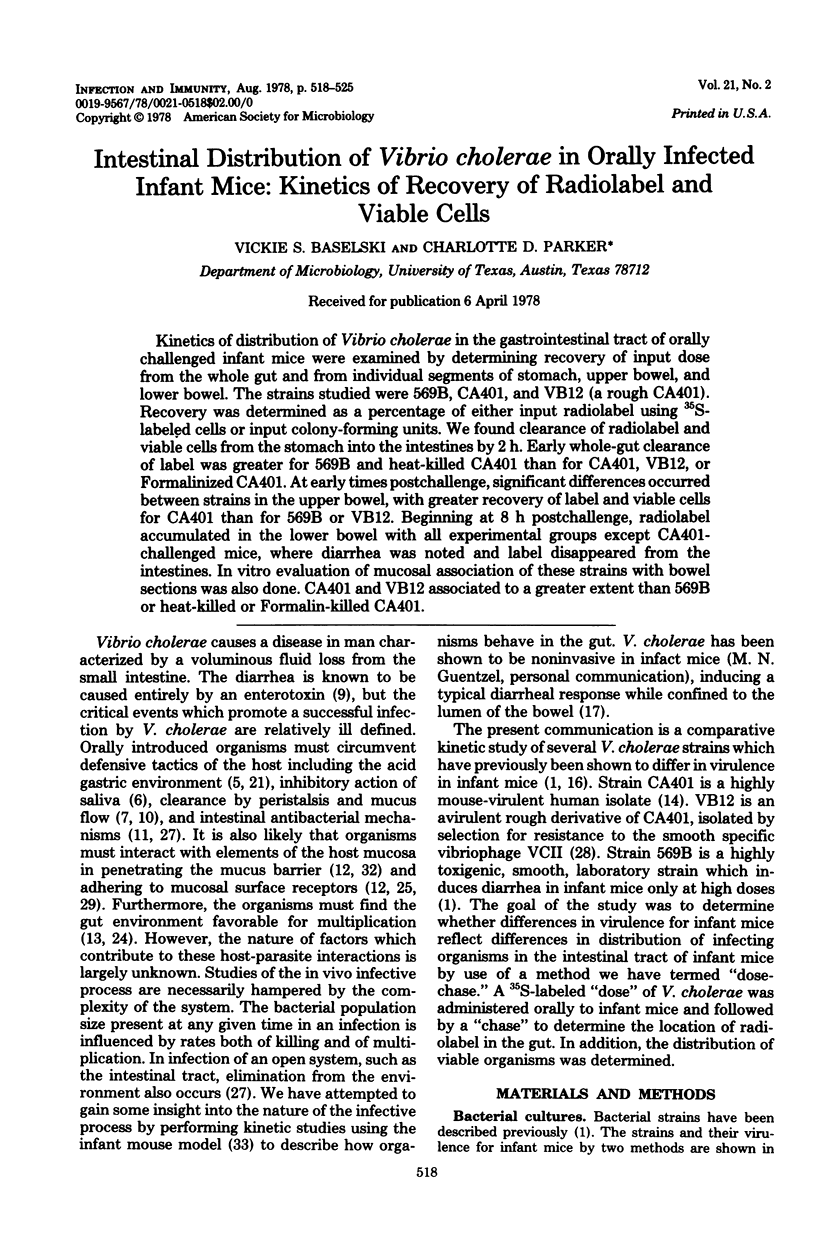
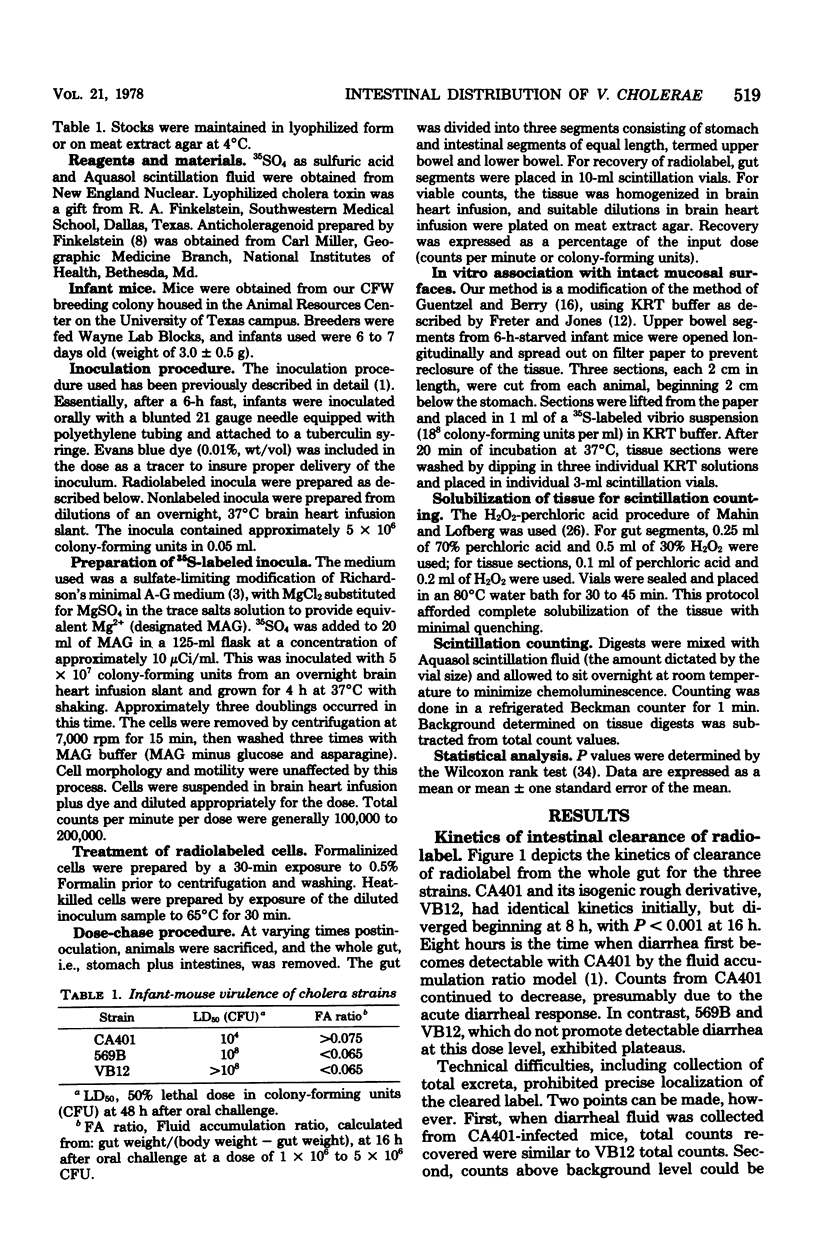
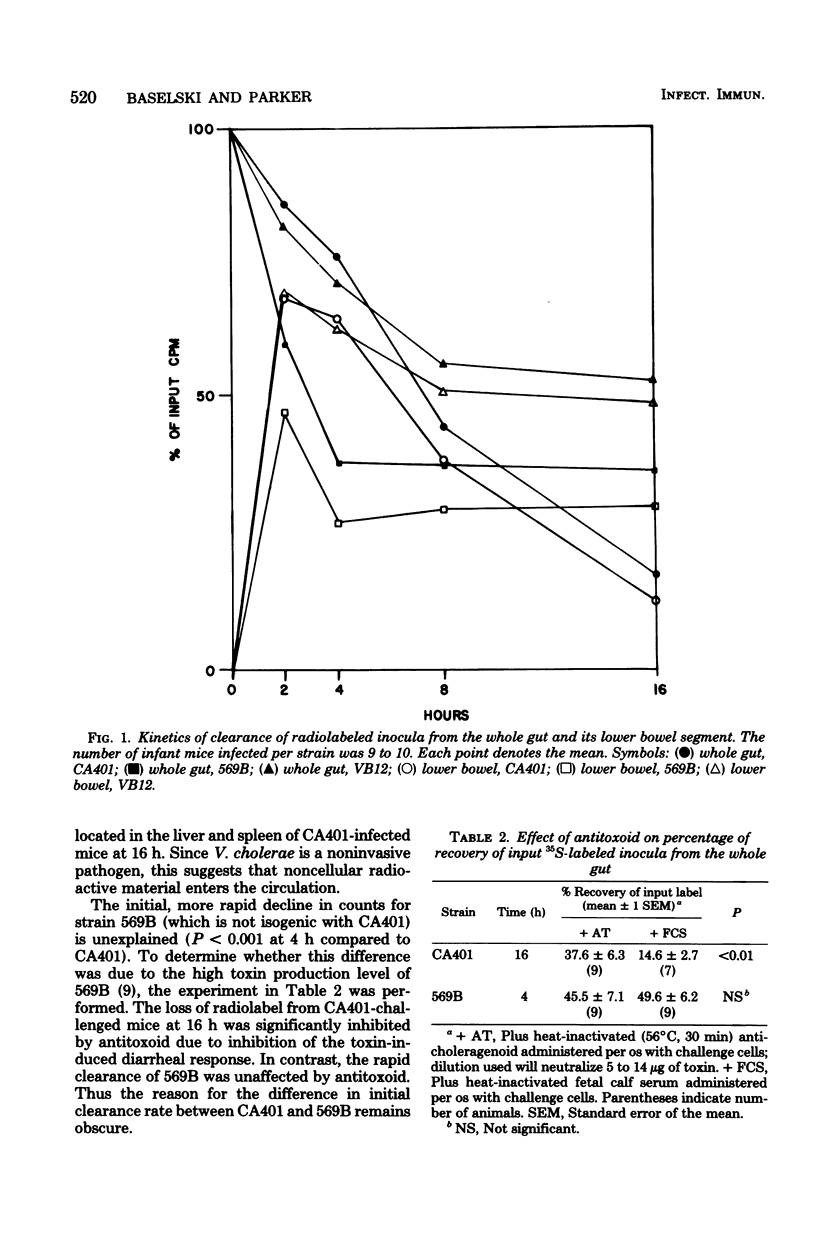
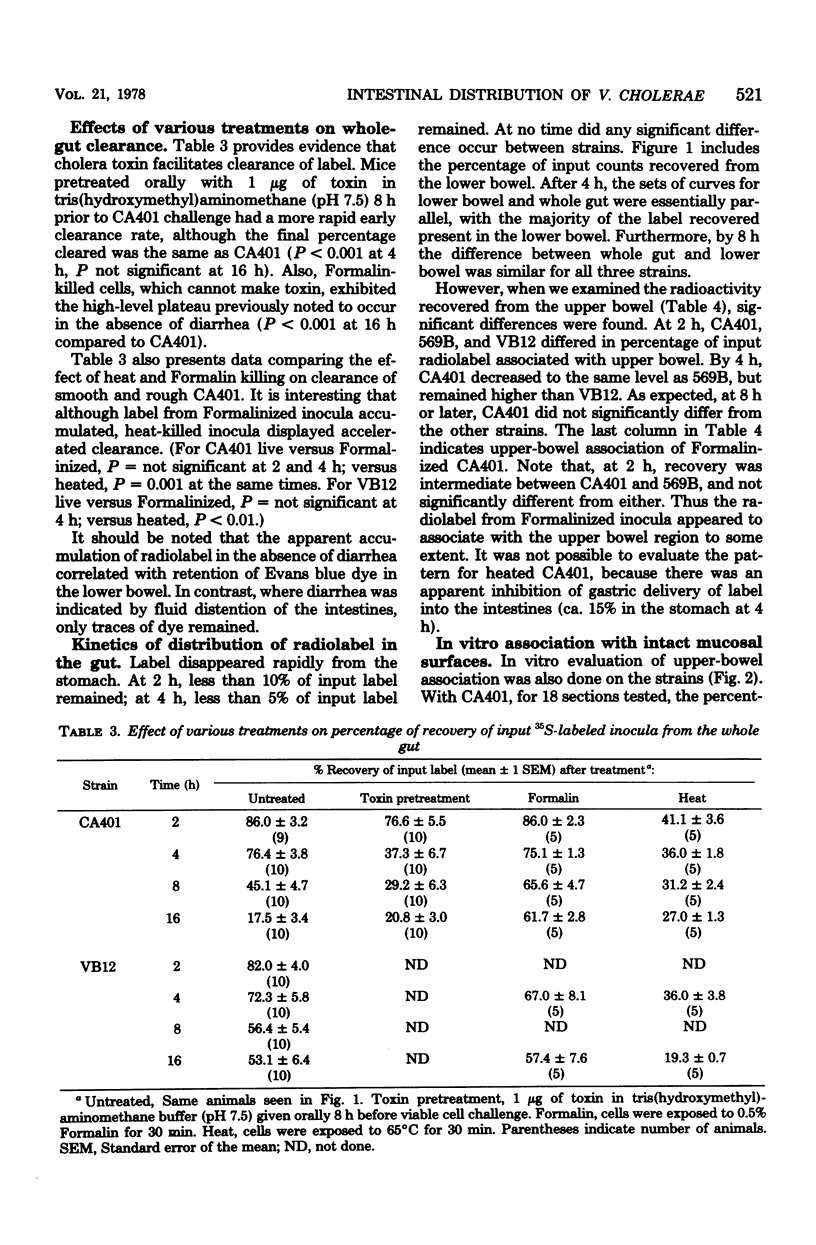
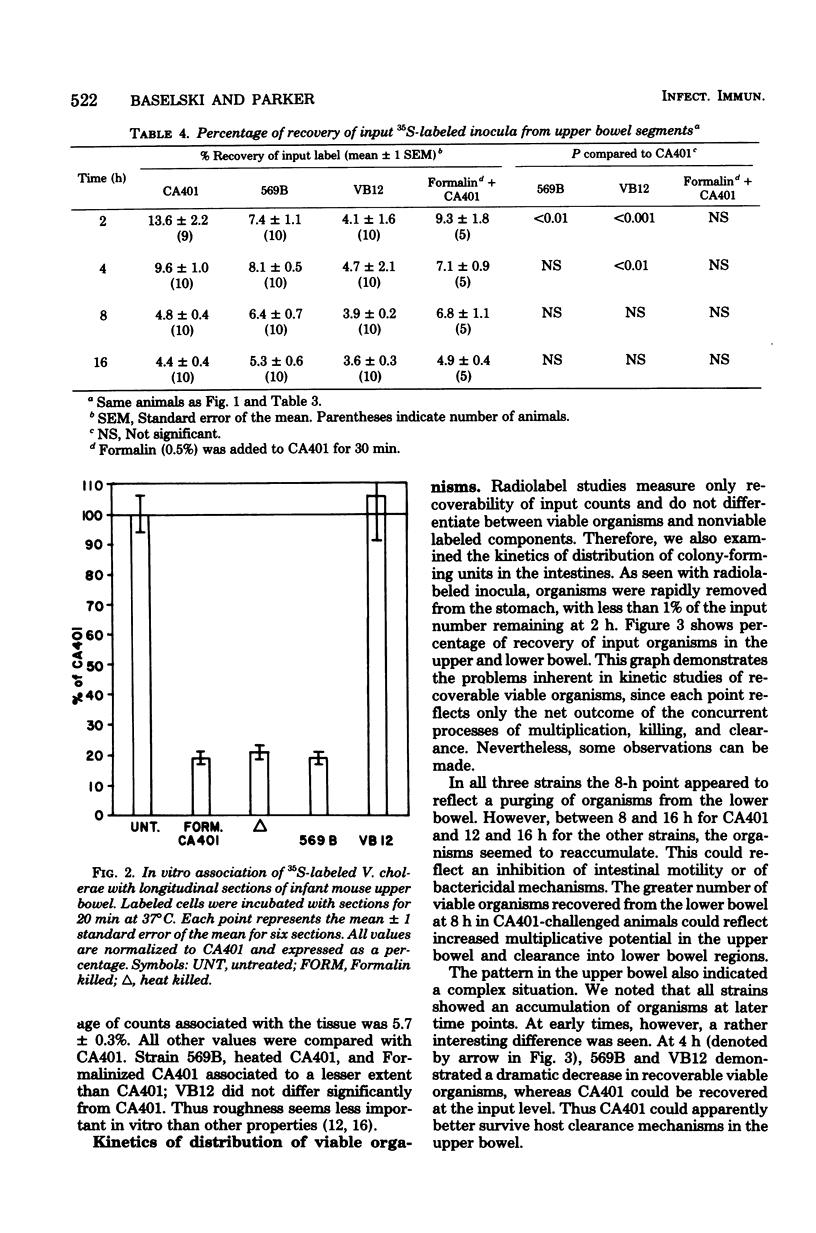
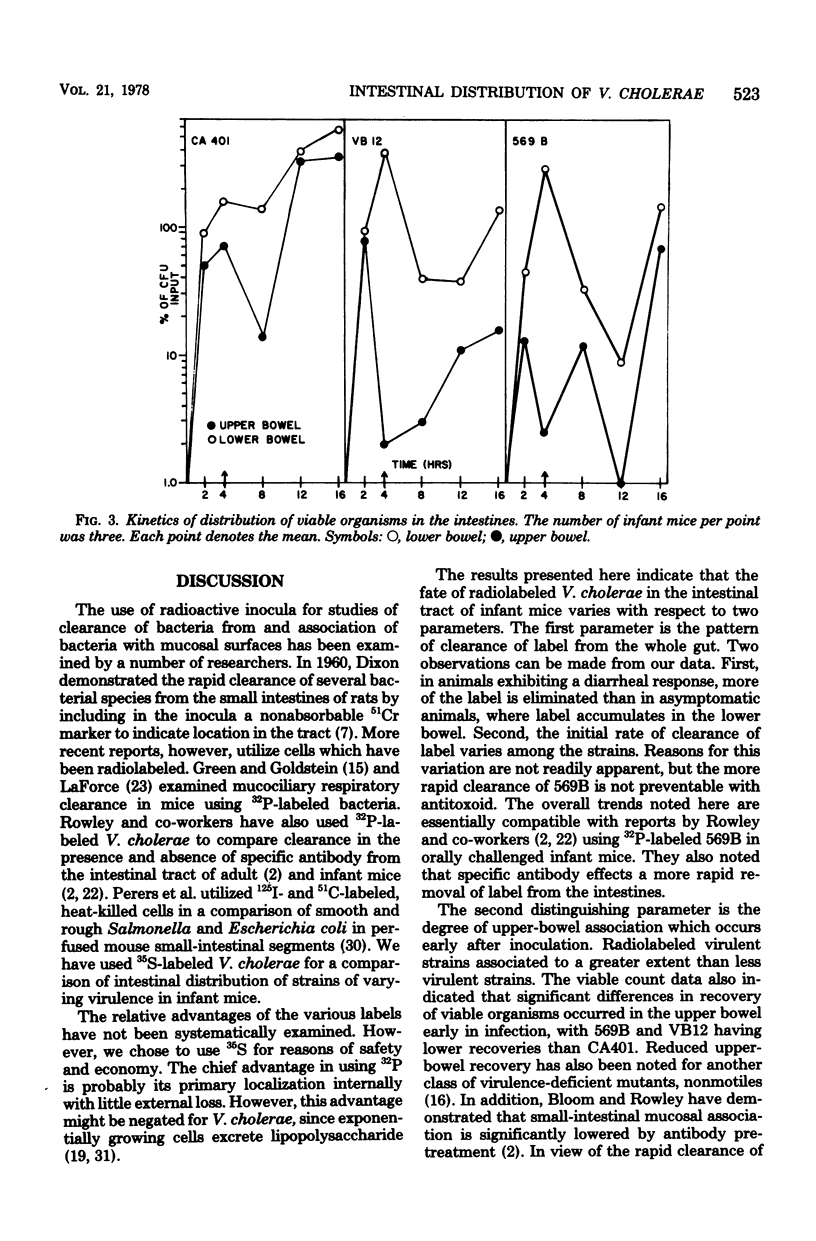
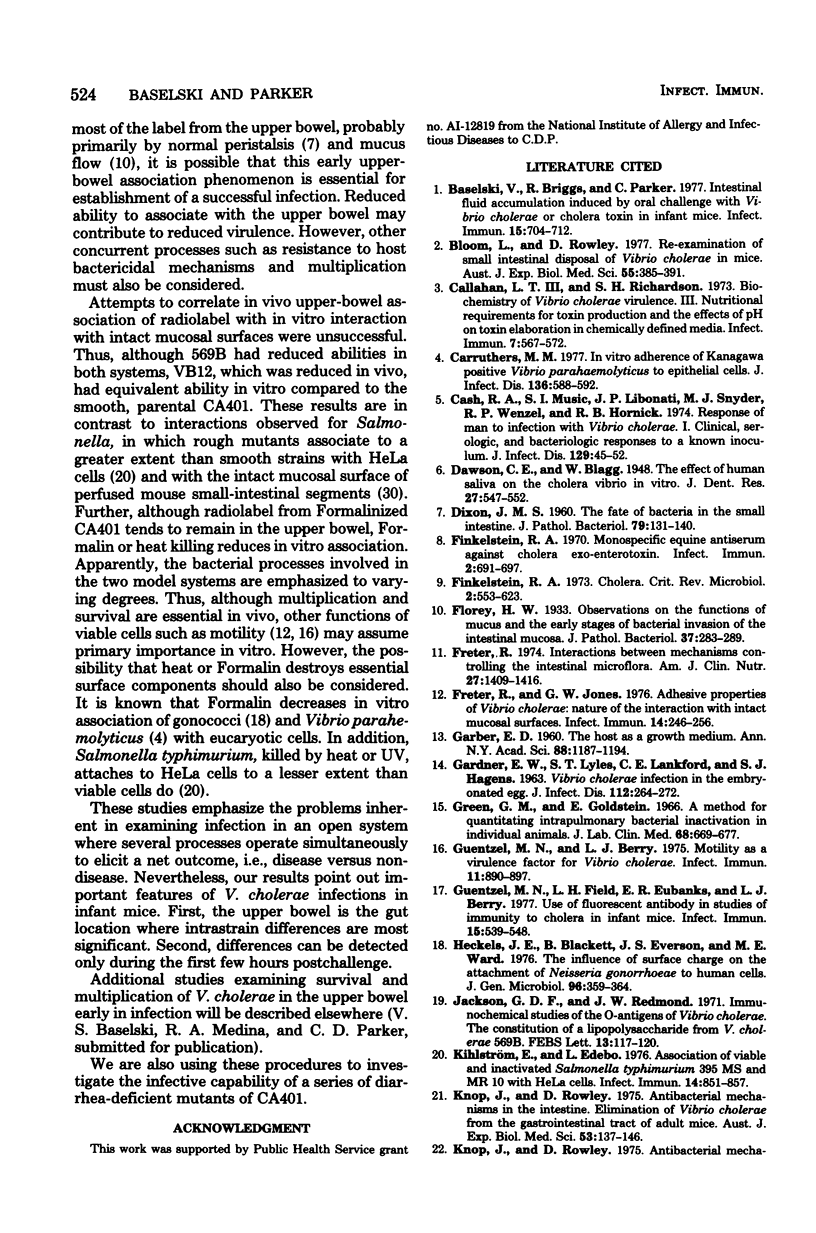
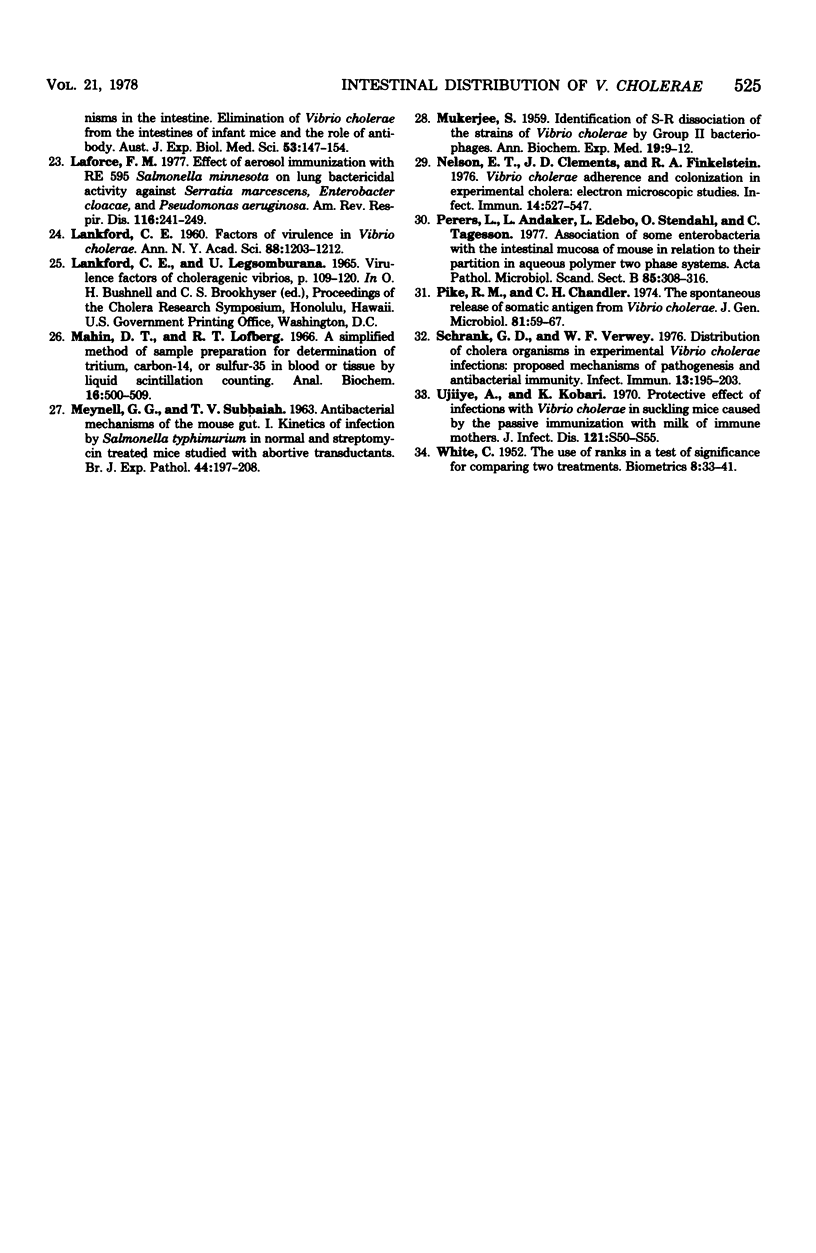
Selected References
These references are in PubMed. This may not be the complete list of references from this article.
- Baselski V., Briggs R., Parker C. Intestinal fluid accumulation induced by oral challenge with Vibrio cholerae or cholera toxin in infant mice. Infect Immun. 1977 Mar;15(3):704–712. doi: 10.1128/iai.15.3.704-712.1977. [DOI] [PMC free article] [PubMed] [Google Scholar]
- Bloom L., Rowley D. Re-examination of small intestinal disposal of Vibrio cholerae in mice. Aust J Exp Biol Med Sci. 1977 Aug;55(4):385–391. doi: 10.1038/icb.1977.35. [DOI] [PubMed] [Google Scholar]
- Callahan L. T., 3rd, Richardson S. H. Biochemistry of Vibrio cholerae virulence. 3. Nutritional requirements for toxin production and the effects of pH on toxin elaboration in chemically defined media. Infect Immun. 1973 Apr;7(4):567–572. doi: 10.1128/iai.7.4.567-572.1973. [DOI] [PMC free article] [PubMed] [Google Scholar]
- Carruthers M. M. In vitro adherence of Kanagawa-positive Vibrio parahaemolyticus to epithelial cells. J Infect Dis. 1977 Oct;136(4):588–592. doi: 10.1093/infdis/136.4.588. [DOI] [PubMed] [Google Scholar]
- Cash R. A., Music S. I., Libonati J. P., Snyder M. J., Wenzel R. P., Hornick R. B. Response of man to infection with Vibrio cholerae. I. Clinical, serologic, and bacteriologic responses to a known inoculum. J Infect Dis. 1974 Jan;129(1):45–52. doi: 10.1093/infdis/129.1.45. [DOI] [PubMed] [Google Scholar]
- DIXON J. M. The fate of bacteria in the small intestine. J Pathol Bacteriol. 1960 Jan;79:131–140. doi: 10.1002/path.1700790116. [DOI] [PubMed] [Google Scholar]
- Finkelstein R. A. Monospecific equine antiserum against cholera exo-enterotoxin. Infect Immun. 1970 Dec;2(6):691–697. doi: 10.1128/iai.2.6.691-697.1970. [DOI] [PMC free article] [PubMed] [Google Scholar]
- Freter R. Interactions between mechanisms controlling the intestinal microflora. Am J Clin Nutr. 1974 Dec;27(12):1409–1416. doi: 10.1093/ajcn/27.12.1409. [DOI] [PubMed] [Google Scholar]
- Freter R., Jones G. W. Adhesive properties of Vibrio cholerae: nature of the interaction with intact mucosal surfaces. Infect Immun. 1976 Jul;14(1):246–256. doi: 10.1128/iai.14.1.246-256.1976. [DOI] [PMC free article] [PubMed] [Google Scholar]
- GARBER E. D. The host as a growth medium. Ann N Y Acad Sci. 1960 Nov 21;88:1187–1194. doi: 10.1111/j.1749-6632.1960.tb20108.x. [DOI] [PubMed] [Google Scholar]
- GARDNER E. W., LYLES S. T., LANKFORD C. E., HAGENS S. J. Vibrio cholerae infection in the embryonated egg. J Infect Dis. 1963 May-Jun;112:264–272. doi: 10.1093/infdis/112.3.264. [DOI] [PubMed] [Google Scholar]
- Green G. M., Goldstein E. A method for quantitating intrapulmonary bacterial inactivation in individual animals. J Lab Clin Med. 1966 Oct;68(4):669–677. [PubMed] [Google Scholar]
- Guentzel M. N., Berry L. J. Motility as a virulence factor for Vibrio cholerae. Infect Immun. 1975 May;11(5):890–897. doi: 10.1128/iai.11.5.890-897.1975. [DOI] [PMC free article] [PubMed] [Google Scholar]
- Guentzel M. N., Field L. H., Eubanks E. R., Berry L. J. Use of fluorescent antibody in studies of immunity to cholera in infant mice. Infect Immun. 1977 Feb;15(2):539–548. doi: 10.1128/iai.15.2.539-548.1977. [DOI] [PMC free article] [PubMed] [Google Scholar]
- Heckels J. E., Blackett B., Everson J. S., Ward M. E. The influence of surface charge on the attachment of Neisseria gonorrhoeae to human cells. J Gen Microbiol. 1976 Oct;96(2):359–364. doi: 10.1099/00221287-96-2-359. [DOI] [PubMed] [Google Scholar]
- Jackson G. D.F., Redmond J. W. Immunochemical studies of the O-antigens of Vibrio cholerae. The constitution of a lipopolysaccharide from V. cholerae 569B (Inaba). FEBS Lett. 1971 Feb 19;13(2):117–120. doi: 10.1016/0014-5793(71)80213-2. [DOI] [PubMed] [Google Scholar]
- Kihlström E., Edebo L. Association of viable and inactivated Salmonella typhimurium 395 MS and MR 10 with HeLa cells. Infect Immun. 1976 Oct;14(4):851–857. doi: 10.1128/iai.14.4.851-857.1976. [DOI] [PMC free article] [PubMed] [Google Scholar]
- Knop J., Rowley D. Antibacterial mechanisms in the intestine. Elimination of V. cholerae from the gastrointestinal tract of adult mice. Aust J Exp Biol Med Sci. 1975 Apr;53(2):137–146. [PubMed] [Google Scholar]
- Knop J., Rowley D. Antibacterial mechanisms in the intestine. Elimination of V. cholerae from the intestines of infant mice and the role of antibody. Aust J Exp Biol Med Sci. 1975 Apr;53(2):147–154. [PubMed] [Google Scholar]
- LANKFORD C. E. Factors of virulence of Vibrio cholerae. Ann N Y Acad Sci. 1960 Nov 21;88:1203–1212. doi: 10.1111/j.1749-6632.1960.tb20111.x. [DOI] [PubMed] [Google Scholar]
- LaForce F. M. Effect of aerosol immunization with RE 595 Salmonella minnesota on lung bactericidal activity against Serratia marcescens, Enterobacter cloacae, and Pseudomonas aeruginosa. Am Rev Respir Dis. 1977 Aug;116(2):241–249. doi: 10.1164/arrd.1977.116.2.241. [DOI] [PubMed] [Google Scholar]
- MEYNELL G. G., SUBBAIAH T. V. Antibacterial mechanisms of the mouse gut. I. Kinetics of infection by Salmonella typhi-murium in normal and streptomycin-treated mice studied with abortive transductants. Br J Exp Pathol. 1963 Apr;44:197–208. [PMC free article] [PubMed] [Google Scholar]
- Nelson E. T., Clements J. D., Finkelstein R. A. Vibrio cholerae adherence and colonization in experimental cholera: electron microscopic studies. Infect Immun. 1976 Aug;14(2):527–547. doi: 10.1128/iai.14.2.527-547.1976. [DOI] [PMC free article] [PubMed] [Google Scholar]
- Perers L., Andåker L., Edebo L., Stendahl O., Tagesson C. Association of some enterobacteria with the intestinal mucosa of mouse in relation to their partition in aqueous polymer two-phase systems. Acta Pathol Microbiol Scand B. 1977 Oct;85B(5):308–316. doi: 10.1111/j.1699-0463.1977.tb01980.x. [DOI] [PubMed] [Google Scholar]
- Pike R. M., Chandler C. H. The spontaneous release of somatic antigen from Vibrio cholerae. J Gen Microbiol. 1974 Mar;81(1):59–67. doi: 10.1099/00221287-81-1-59. [DOI] [PubMed] [Google Scholar]
- Schrank G. D., Verwey W. F. Distribution of cholera organisms in experimental Vibrio cholerae infections: proposed mechanisms of pathogenesis and antibacterial immunity. Infect Immun. 1976 Jan;13(1):195–203. doi: 10.1128/iai.13.1.195-203.1976. [DOI] [PMC free article] [PubMed] [Google Scholar]
- Walsh J. H., Yalow R., Berson S. A. Detection of Australia antigen and antibody by means of radioimmunoassay techniques. J Infect Dis. 1970 May;121(5):550–554. doi: 10.1093/infdis/121.5.550. [DOI] [PubMed] [Google Scholar]


